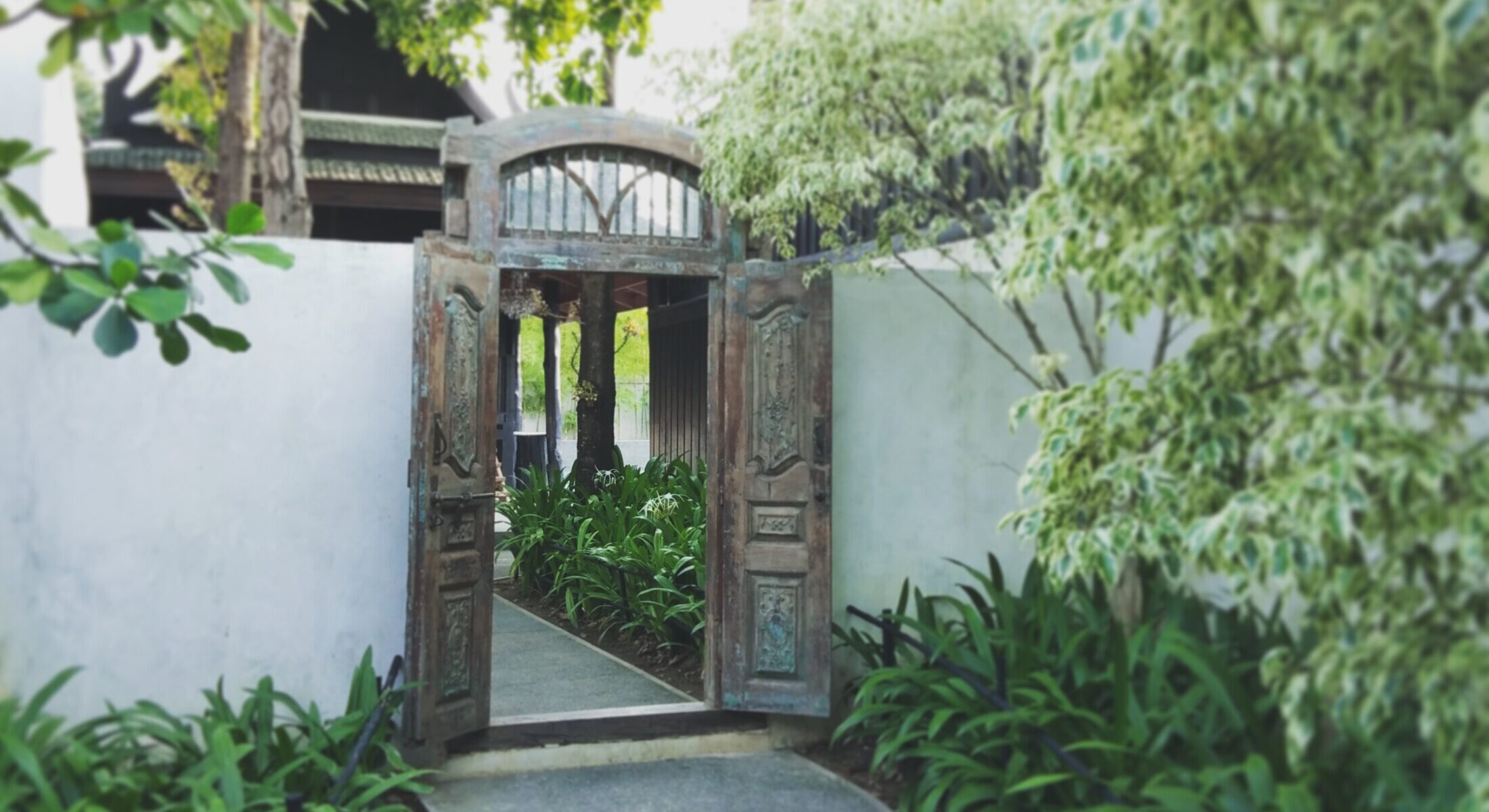Our Story
The Thai Houses
Authentic Thai houses are typically constructed using a traditional building method that does not involve the use of nails. This method is known as “tongue-and-groove” or “slotted-together” construction.
The process begins by cutting and shaping wooden planks to the desired size and shape. The planks are then carefully notched, or grooved, along the edges so that they fit together snugly, like puzzle pieces. Once the notches are cut, the planks are slotted together, creating a strong, interlocking joint.
The use of this method allows the houses to be assembled and disassembled easily, making them perfect for temporary or mobile structures. The joints are also flexible, allowing the house to move with the natural expansion and contraction of the wood. This also provides a natural ventilation system, keeping the house cool and damp-free.
The wooden joints are then reinforced with wooden pegs and bamboo dowels, creating an exceptionally strong and durable structure. The structure is then finished with traditional Thai architectural designs such as intricate carvings, wooden lattice work, and colorful paintwork.
This traditional building method is not only efficient, but also sustainable and environmentally friendly. It uses natural materials and does not require the use of chemical adhesives or metal fasteners, making it a perfect choice for the preservation of Thai culture and architecture.
The Villas
101 is a large golden teak house with a beautiful proportion befitting a wealthy owner. The house was purchased from the village of Bang Mae Mai, Bang Pla Ma District in Suphanburi Province. The outside wall is a familiar one called ‘Fah Pakon’, formed of vertical and horizontal wooden panels with an interlocking wooden plank forming a Thai pattern. The pediment, triangular part of the roof, sees the curved plains meet. The pillars and walls retain the traces of centuries past.
102 is a large and spacious house. The original owner, Pol Daeng family, has been taking care of this house for a long time. Being owned by a well-off family allows the house to be kept in prime condition. The designer of this house intends to show off the beauty of the roof tiles, handmade with an ancient technique that is now lost. The glazed tiles will shine most brightly in the morning as the morning light shines through the tiny gaps between them.
103 or Villa Doi Suthep is connected with 101 and 102 using the old Thai way when the housing complex is extended, a balcony. The unique pattern of its outside wall is called ‘Fah Sumruad’ which is characterized by having mainly vertical wooden bars separated by 1 palm of a hand. Between these bars, small wooden pieces are laid crosswise. Behind, the pattern is paneled with young leaves and polished with another layer of bamboo. This is ancient wisdom creating ventilation making the interior cool and comfortable.
From the window of this villa, up from the dark swimming pool and past the lobby upwards, the golden pagoda can be seen on the green ridge of Doi Suthep.
201 is a house with the wall pattern called ‘Fah Luuk Fuk’. It is another style of Thai house using whole sheets of teak and pressing in the pattern to create exquisite edges using Chinese woodwork technique that remains from the long established link between the nations. Originally, the basement of the house was used to raise animals and as storage. It is now converted into an open-air living room where the furniture is placed in one of the most photogenic corners in the resort. This view can be seen in many of the world’s leading travel magazines.
The house is located in the arbor of the golden peacock tree that will bloom a dazzling yellow in May.
204 has the same pattern as 201, ‘Fah Luuk Fuk’. It belonged to a Chinese merchant who came to trade and settled in Suphan Buri Province. A beautiful reminder of the past can be seen in the lion carving above the bedroom door. The designer chose the French-Chinese lion-patterned silk to compliment the lion carving.
The house has a partly hidden terrace where you can admire the shaded garden and the hotel’s main swimming pool.
301 or Villa Aunt Thong-jerm is the first house built in this resort. She sold her beautiful house in Suphan Buri Province and it became the first pillar established which is a traditionally significant step in the building process. According to the Thai principle of building houses, this first pillar warranted a ceremony on that Tongchai day. It is done for prosperity for the owners and residents of the villa, for happiness and for pleasantness.
302 stands opposite Villa Aunt Thong-jerm. The house is from Chorakhe Sam Phan Subdistrict, U Thong District in Suphan Buri Province. It is a modest sized ‘Fah Pakon’ house with perfect proportions. The roof is sloping at 61 degrees which is the perfect slope especially in the heavy rainy season. The steeper the slope, the better the rainwater drainage. But it is also a delicate balance as a very steep slope will cause the architectural proportion to be out of balance.
Zone 4 is a private pool villa area consisting of 2 Thai houses with a dark swimming pool between them. The walled area is shaded with trees and decorated with volcanic stone statues from Bali in the image of Lady Sita from Mahabharata literature. The other sculptures are by local artist, Chamnian Thongma.
401 came from Ratchaburi Province about 100 kilometers southwest of Bangkok. It is a large Thai-style house with the ‘Fah Luuk Fuk’ pattern including its windows which is rarely seen. The wall separating the room is an antique Chinese perforated screen, an important piece from the owner’s collection. The bathroom door handle is an important art piece from a gallery in Venice. The basement of this house is vast and opens to the swimming pool.
402 came from Mae Klong River, Amphawa District, Samut Songkhram Province south of Bangkok where many beautiful authentic Thai houses can still be seen. The ‘Fah Pakon’ house was located on the waterfront with the owner trading on Mae Klong River. The house was not raised up very high on the pillars so they decided to put wrought iron on the windows to prevent theft from the riverside during the night. One unique thing for this house is Lion’s foot bas-relief wood carving or lion base under the window called “Singha’s feet” that can only be found in Amphawa and nearby areas. The house is lit by a 3-bouquet chandelier from France and is decorated with Chinese scenes with auspicious animal patterns. It is considered one of the most elegant villas in the resort.
Zone 5 is another private pool villa area with a group of 3 Thai houses arranged according to a Chinese house plan with a courtyard in the center. The swimming pool is hidden in a private corner surrounded by 6-meter stone walls.
501 is a ‘Fah Pakon’ house from Sri Prachan District in Suphanburi Province. It faces the south at an angle that receives very good natural light. This house has always been used as a family treasure trove. Ancient Thai houses do not have a fence or wall around the perimeter so they keep valuables inside the rooms while the members of the family spend their time outside on the terrace with a mosquito net. The headboard in this house is lined with fabric with the deity pattern of Thai Ayutthaya art, in harmony with the wooden backdrop. The teak flooring gets better with age and needs no special coating.
502 is also a ‘Fah Pakon’ house. It is from the bank of Chao Phraya River in Nonthaburi Province. The appearance of this house shows that it is a commercial house by the river, not raised too high on the pillars. The balcony on the riverside can be open for docking boats. It is assumed that this house was built during the reign of King Rama III (between 1824 – 1854), or around 150 – 200 years ago. This is because of the yoke or the carvings under the windows with Pod Duang patterns which was the money used in the early Rattanakosin era. Pudtan flower and Chinese wrench patterns also indicate trade links with the Chinese empire from the time of King Rama 3 where he bestowed land in the said area for the Chinese to live and trade. With his mother, Chao Chom Riam, also of Chinese descent was born in Nonthaburi Province as well.
503 Another ‘Fah Pakon’ house from Bang Pla Ma District in Suphanburi Province where there are still clusters of Thai houses to be seen in the rice fields. This house is not a luxury one, but it is beautifully proportioned according to traditional Thai houses. The head of the bed is decorated with blue silk with a bright blue peacock tail pattern matching the brass stems of the chandelier, which is one of the most elegant pieces in the resort.
Pairoj House is the Buddha house of Villa Mahabhirom. Traditionally, Thai houses and compounds will have a hall or room to house Buddha for worshiping as well as to promote prosperity. This is a small house with only 2 rooms and 6 pillars as it was used as a kitchen. Normal houses will have 3 rooms with 8-9 pillars. The design is a ‘Fah Sai Bua’ meaning lotus stem. Thai houses are functional houses built according to its usage. For this house, the top has an opening for the vent and a low window as people in the kitchen tend to sit on the floor.
In the house, the Buddha statue is in the style of Mandalay. The Burmese art is elegant and auspicious. Below the house, there is a cupboard for dhamma books and prayers with watering patterns. The feet have a beautiful and rare lion’s pattern.
The Spa house is an example of ‘jae’ roof design or a roof with a slope of less than 61 degrees. The compact house was brought from Ratchaburi Province which is approximately 100 kilometers southwest of Bangkok along the Mae Klong River. The amount of rain in the area is less than the North of Central Region resulting in the shallower slope. The partitions for the massage rooms were walls that the previous owner used as chicken coops. The designer found this house accidentally finding the wall pattern interesting and finding the craftsmanship exquisite.



